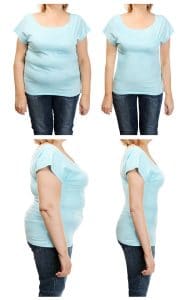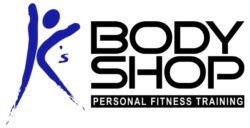
Many people contact me looking for an exercise program to get rid of menopause belly fat without understanding the hierarchy of fat loss in midlife women.
Things are different now, and what worked in your younger years may push you deeper into hormone imbalance now.
While exercise is obviously an important part of health at any age, there is no magic exercise program that will undo the damage caused by other poor lifestyle habits.
That being said, even if you are already getting enough good quality sleep, managing stress, and eating clean and in balance, exercise matters. The type of exercise, amount, intensity, and time of day all come in to play – now more than ever.
Recovery from exercise is also a critical component – not only for fat loss, but for maintaining your strength (lean muscle).
While there does need to be a slight caloric deficit for fat loss, cutting food intake too aggressively or exercising too much can actually make things worse. So forget the old strategy of “exercise more and eat less.”
Why?
It’s all about balancing hormones – and probably not the ones you think. Estrogen and progesterone have left the building and they aren’t coming back. Even hormone replacement therapy only replaces the hormones, not the receptors on the cells that also decrease in number with age.
So, let’s focus on what we have control over: particularly managing cortisol and insulin, both of which can lead to increased belly fat.
Hierarchy of Fat Loss in Midlife Women
In life we have these things called “hierarchies.” A hierarchy is simply a list of what to do first. Once you are doing #1 consistently, you move to #2. Once you’re consistent with #2, then #3 and so on and so forth.
So, the first thing on the list is typically what will get you the most bang for your buck at first and the things further down the list won’t help much if you haven’t mastered the things at the top.
What’s the most effective hierarchy of fat loss for midlife women?
Probably not what you expect:
- Sleep – both quality and quantity. I wrote an entire post explaining how poor sleep can lead to fat gain. Muscle growth and repair happens during the deep stages of sleep. Hormones that control appetite get out of whack, making you crave more food – especially sweets. If you don’t feel rested in the morning, you’re not getting enough. And no exercise program or diet plan will overcome the hormone imbalances caused by poor sleep.
- See #1. Really. Didn’t see that one coming, did ya? Best chance of balancing many hormones just by doing this.
- Stress Management – Stress = Fat Storage. This includes not only emotional stress, but toxins in your food and environment, food sensitivities, managing chronic diseases, poor sleep, cutting calories too much, and…. hormone imbalances. Menopause itself is a stress. Poor sleep is a stress. Exercise is also a stress. Adding more stress to an already overstressed system leads to a greater hormone imbalance and more belly fat. Gentle forms of Yoga, Pilates, stretching, or walking in nature can work well here. Goes hand in hand with #1.
- Nutrition – eat real food, in balance, preferably organic, in the right amount so that you get all of the nutrients you need without excess calories. It’s not about starving yourself (that is a stress that leads to slower metabolism and fat storage). Prioritize protein. And ditch the alcohol, which stops fat burning in its tracks.
- See #4. Even if you’re sleeping well and managing stress, you’re not going to out-train a crappy diet. It really is that important.
- Strength Training – lifting heavy shit helps preserve muscle and bone and increases metabolism. Muscle acts like a sponge for blood sugar and insulin, resulting in improved insulin sensitivity and less belly fat. Strength training is also what’s most likely to keep you out of the nursing home further down the line.
- HIIT – high intensity interval training elevates metabolism and burns calories long after the exercise session has ended. If you’re ready, willing and able to do the work, this can be very effective for fat loss, insulin sensitivity, and better cardiovascular health. Don’t attempt until you’ve nailed #1 or you could make things worse.
- Walking – it’s a functional activity and can be done anywhere, any time, and doesn’t cost anything. Doesn’t elevate metabolism or do much for muscle or bone density, but still has many health benefits. And no, it doesn’t have to be “power” walking.
- NEAT – general physical activity, or simply just “moving around” such as getting up to do a task. At least you’re not sitting 🙂
This list may seem counterintuitive, but hormone balancing exercise and healthy lifestyle habits help preserve lean muscle, manage blood sugar levels, and minimize stress so that your body can burn fat instead of store it.
You’ll notice that moderate steady state cardio like running and biking aren’t on the list. That’s because many women going through the midlife transition find that the increased cortisol caused by endurance exercise drives them deeper into hormone imbalance. Like all things, some women will be able to continue running marathons or doing Ironman triathlons without any trouble. They aren’t the ones reading this post.
We are less resilient to stress during and after the menopause transition, so we simply can’t get away with many of the things we once did. We also no longer get a metabolism boost with the monthly menstrual cycle, so it’s no wonder you’re gaining weight if you haven’t changed your eating or activity level.
So – Sleep deep, stress less, eat real food in balance, not too much or too little.
Then, and only then, will a properly designed exercise program that allows for enough recovery while also incorporating appropriate intensity get you the results that you want.

Feeling Overwhelmed?
Now that you know the hierarchy of fat loss in midlife women, just knowing is the easy part.
You have to actually do it.
Consistently.
Coaching midlife women how to lose menopause belly fat while improving or maintaining their strength is what I do for a living.
I’m in the same boat, rowing right along with you.
Contact me today if you’re ready to start living your best life.
